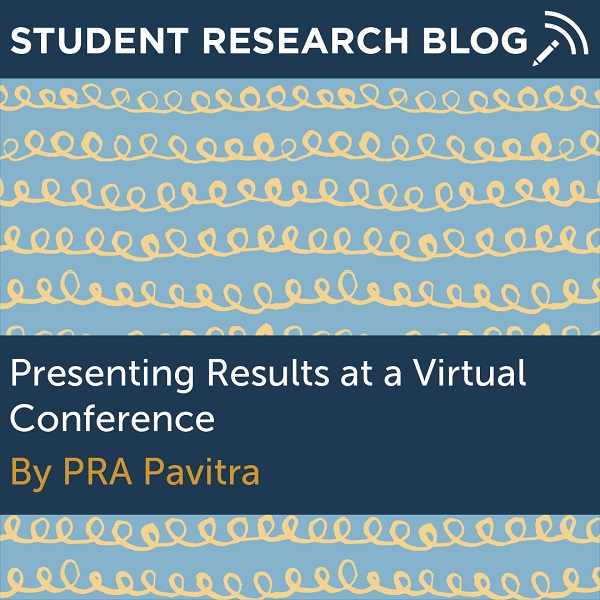 By Pavitra Makarla, Peer Research Ambassador
By Pavitra Makarla, Peer Research Ambassador
It may seem nerve-wracking at first when you begin preparing to present your research at conferences, and the prospect of doing it virtually can be even more intimidating. I’m here to tell you that online presentations are not as difficult as you think it might be — all it takes is some extra preparation and a little bit of confidence.
I presented my data at the Cognitive Neuroscience Society (CNS) Virtual Conference in 2020, as well as in the Frontiers in Undergraduate Research Exhibitions (2020). Both conferences were vastly different in procedure, but I had to prepare essentially the same things.
First, let’s talk about the poster. The poster is the most important part of the presentation, as it is a condensed version of your goal for the research, your methods, all of your findings, and your conclusions. Given that research is usually a long process with a lot of data produced in the end, it can seem like putting all of that information on one poster board is close to impossible, but I can most definitely tell you that it’s not! Your PI is an invaluable resource when preparing your poster. They know exactly what pieces of information are relevant for the audience to know, and can help you pick and choose what to put on the poster. One thing to keep in mind is readability: you are presenting research that you have put time and effort into understanding, but other people might not know exactly what you’re talking about. It is important to keep the verbiage as clear and concise as possible while catering to the layperson. This way, they know what your research is and can engage with you on the subject.
Each conference has its own set of rules and regulations; it’s important to find out exactly what each conference requires beforehand so that you know exactly what is expected of you. The CNS 2020 virtual conference was much different than the Frontiers Exhibition at UConn, and I had to prepare slightly different items for both. For the CNS conference, it was enough for me to have my poster — that way, I can engage with the audience using the chat function provided to answer any questions that they may have. For the Frontiers Exhibition, I had to prepare a short video describing what my research was about (for my presentation to use as a reference, click here). Either way, a poster is almost always required, and whether or not you present live or use a pre-recorded video is important to keep track of.
Another thing to keep in mind is that conferences are not just there for you to disseminate your research, but to also learn about what other scientists are doing in their respective fields. This is essentially a network hub; it’s a great way for you to make connections to other researchers and create contacts and points of reference when and if you need them later on. It can seem daunting to try and network at a virtual presentation as compared to in-person, but it’s just the same. For some conferences, like the CNS conference, there’s a chat function that allows people to drop into your poster session and ask questions.
One last point: don’t be afraid to present and network! I know it’s easier said than done, but even academics at a conference are there to learn. They aren’t there to point out your mistakes, but rather understand what you’ve learned and maybe take back what they’ve learned to apply it to their own research.
Virtual presentations are not much different from meetings in-person. If anything, I want you to take away the following from this post: conferences are a learning experience for everyone involved — give as much knowledge as you take away from the meeting, and don’t be afraid to make new connections!
Good luck!
Pavitra is a senior majoring in Cognitive Science and minoring in Neuroscience and Psychological Sciences. Click here to learn more about Pavitra.